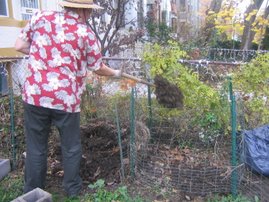 The fava bean is the original Old Wold bean. Other beans originated in the Americas. Picked when the pods are green and plump, the barely mature beans are sweat and tender, tasting like fresh peas. But getting them from the garden to the dinner plate takes a bit of work.
The fava bean is the original Old Wold bean. Other beans originated in the Americas. Picked when the pods are green and plump, the barely mature beans are sweat and tender, tasting like fresh peas. But getting them from the garden to the dinner plate takes a bit of work.The fava bean is doubly protected--first in a very large pod with a pillowy lining, then inside a fairly tough casing.

To extract the bean from the casing, blanch the beans in a large pot of boiling water for 30 seconds. Transfer the beans to a bowl of cold water to arrest the cooking process. This can be done in batches. Allow the water to come back to a boil before proceeding with the next batch.

On one end of the casing you'll notice a very dark indent. This represents the fava's belly button.

The other end is smooth, with an airfoil shape.

To open the casing, use the tip of a paring knife to make a crescent-shaped incision along the smooth end.

Gently squeeze between thumb and forefinger at the opposite end. The bean should slide out. Older beans are more difficult to remove--another reason to pick the favas at their peak, when the pods are plump and bright green. A dull or browning pod indicates advanced age.

Free of its casing, the fava is ready to finish cooking any way you'd like.

This bowlful of blanched and shelled favas represents our entire harvest from 50 plants. I'm thinking lightly sauteed with onion and a little butter. Or maybe smeared on bruschetta with pecorino cheese....











7 comments:
I think fava's are one of nature's funniest foods. I just love the big pod they come in. We got some with our CSA box last week and I made them into a sauce with quinoa and chicken. If you're interested it's on my blog: http://freshandfeisty.blogspot.com/2008/06/but-i-dont-like-spinach.html.
Thanks. I really enjoy reading your posts!
Wow, Ed ... how long did that take you? SO much patience.
Joanna
NUTME, what a great thing, getting favas in your CSA box. I hope you have thanked your farmer profusely.
Joanna, I won't lie--these favas don't sheel themselves. I think it took me about an hour. The fingers were a bit tired by the end.
Thanks, Ed... I'm looking forward to doing the same. About how big are the pods when they're ready to pick? I have a couple right now that look like maybe they're ready, but I'm not sure. How do I tell?
Jennifer, some of the pods will get really huge--10 inches long and as big around as your thumb. But I also found that some pods that don't get nearly that long--that may be quite short--also develop full-sized beans, but maybe just one or two. And some beans do mature a bit quicker than others. As you can see in the last picture above, some of the beans have started to turn from bright green to a sort of dull yellow, meaning I could have picked some of these beans a week ago. I don't know how else to tell when they're ready except to crack one open and look inside. The pod should look very swollen and a bright, glossy green.
What a fabulous guide to fresh fava beans, I think we call them broad bean beans here in the UK. I love the last picture where they are all ready to be cooked, the colour is amazing.
Jeena, you are correct--broad beans no your side of the Atlantic. And they do have a terrific green color.
Post a Comment